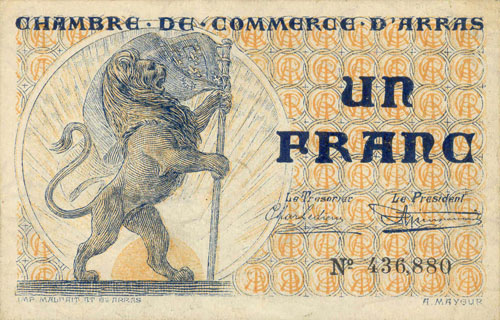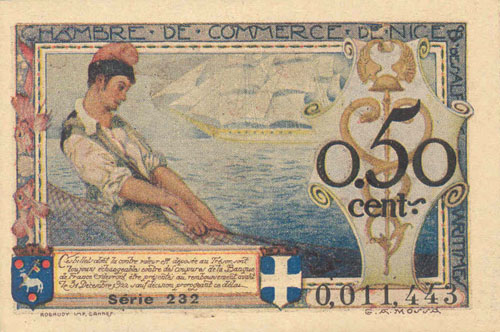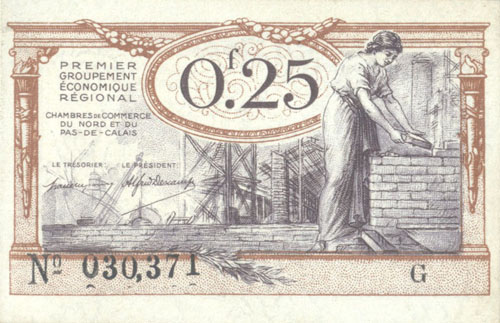Art Regionalna we Francji Wojną
During the First World War, France had more important things to do than design and issue banknotes. Inflation had set in, coinage was scarce, and all attention was on the war. While the large percentage of emergency banknotes issued reflect the need to get something out fast and cheap, there are some gems to be found. These notes were designed by lesser known artists and printed hurriedly by local printers, but we can see pride in the regional motifs and truly artistic work in these small notes.
Pieniądz Zastępczy
The term "emergency note" covers any note, bond or debt mechanism that was issued as a result of the central bank not being able to provide the service. Typically emergency notes were used during wartime. One group of these notes are the French Chamber of Commerce notes of WWI1.
At the start of the first world war in 1914, France immediately suspended use of gold coins and the conversion of banknotes to gold. As inflation grew, French coinage was being hoarded for its gold and silver content. Merchants were unable to process small transactions with customers. In August of 1914, the Chamber of Commerce of Paris requested, and was authorized to issue small bearer bonds in denominations of 0.25F, 0.5F, 1F, 2F, that would be legal tender among the Paris merchants that agreed to accept them. As financial backing, the Chamber of Commerce would place an equivalent amount of cash on deposit with the Banque de France.

Soon thereafter, the Chambers of Commerce of other cities throughout France implemented the same mechanism as done in Paris, and issued their own bearer bonds for local use.
This system was maintained for at least five years, at which time its faults started to show; paper money was not able to withstand the constant handling required of small denominations, and the bonds were being used beyond the local scope of each Chamber of Commerce. In 1921, it was decided to issue bronzed plated aluminum "Jetons", in 0.5F, 1F and 2F denominations, to replace the paper bearer bonds. These Jetons were usable across the country.

Arras
The city of Arras, near the France/Belgium border, was heavily damaged during WWI. Represented on its note (fig 1) is the Lion of Arras, and the sun representing King Louis XIV, that sits atop the gothic Belfry of Arras.
This note, number 13.1 in the catalog2, was designed by A. Mayeur and printed by Malfait et Cie. in Arras.
Bordeaux
Bordeaux is the wine capital of the world, a port city on the west coast of France. Several beautifully designed, yet quickly printed notes from the city reflect the importance of trade to the region (fig 2).
This note was designed by F. M. Roganeau, and printed by Wetterwald Frères.

Grenoble
Grenoble is at the base of the French Alps, near Italy. It chose two of its most famous military heroes of the Renaissance, Bayard and Lesdiguières, to be on one of its notes (fig 3).
This note was designed by Farcy, engraved by Coquand, and printed by Établissements de l'Imprimerie Générale, Grenoble.

Nice
Nice has long been a home of the rich and famous, and the second largest tourism destination in France. The vibrant colors in its notes (fig 4) are rare among the Chamber of Commerce issues, and reflect the Mediterranean climate and lifestyle.
This note was designed by G. A. Mossa and printed by Robaudy, Cannes.

Pas-de-Calais
On the very north-east coast of France, the Pas-de-Calais region was one of the most heavily impacted during WWI. Its notes are some of the few that show bombed and burned cities, and hopeful restoration work (fig 5).
Unfortunately the Pas-de-Calais notes list no designer or printer.